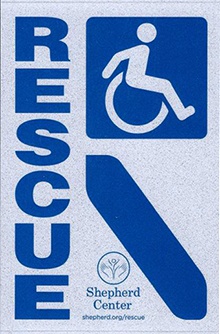by Mike Kennedy.png)
“According to the Federal Emergency Management Agency (FEMA), “People with mobility impairments represent a segment of the population with one of the highest risks of dying in a fire.” Based on recent U.S. Census Bureau information, this represents about 21.2 million Americans.”
“According to incident reports filed by local fire departments, physical disability was a factor in an average of 380, or 14%, of home fire deaths per year between 2004 and 2008.”
Had anyone asked me before November 1st 2013 to guess how many people in the United States were disabled, my answer probably would have been a vague “not very many” or “a very small percentage.” To me that answer is not surprising because before that day I wasn’t disabled and I submit that most of us tend to think that way. However, on 1 November, I suffered an accident that left me disabled. Before November 1st 2013, I would never have believed that in 2010 there were an estimated (2) 56.7 million disabled Americans (3). According to a U.S. Census Bureau report by Matthew W. Brault and issued in July 2012, 38.3 million have disabilities that are categorized as severe. The Census Bureau report categorizes severe disabilities into three categories; communicative, mental, and physical.
Severe communicative disabilities include:
1. Blindness or difficulty seeing.
2. Deafness or difficulty hearing.
3. Difficulty having their speech understood. (Also see in this issue, “Q&A with Tracy Wallace”, an article on Aphasia here)
Severe mental (cognitive) disabilities include:
1. Learning disability, intellectual disability, developmental disability or Alzheimer’s disease, senility, or dementia.
2. Some other mental or emotional condition that seriously interfered with everyday activities.
Severe physical (mobility) disabilities include:
1. Use a wheelchair, cane, crutches, or walker.
2. Have difficulty walking a quarter of a mile, climbing a flight of stairs, lifting something as heavy as a 10-pound bag of groceries, grasping objects, or getting in or out of bed.
3. Arthritis or rheumatism, back or spine problem, broken bone or fracture, cancer, cerebral palsy, diabetes, epilepsy, head or spinal cord injury, heart trouble or atherosclerosis, hernia or
rupture, high blood pressure, kidney problems, lung or respiratory problem, missing limbs, paralysis, stiffness or deformity of limbs, stomach/digestive problems, stroke, thyroid problem, or tumor/cyst/growth as a condition contributing to a reported activity limitation.
How does your agency rescue and treat someone if they cannot see, hear, or whose speech is difficult to understand? How do you know that those needing rescue and/or treat have severe disabilities?
Train and Prepare to Respond to the Disabled
One program to assist responders and those with disabilities was developed by a partnership between Shepherd Center, a rehabilitation hospital for catastrophic injuries in Atlanta, Georgia, and the DeKalb County Fire Department, DeKalb, GA., to create the RESCUE program. This is a community service program providing home alert labels and education for people with physical and or cognitive limitations who find themselves in emergency situations. The mission is to aide in quicker response times and creation of better emergency plans.

http://www.shepherd.org/resources/rescue
This program can be duplicated and implemented in your local community. The program resources include a sticker to be placed in a visible front window of a disabled person’s home, an information card, and a letter the disabled person can give to the local fire department. Shepherd Center can help your community start or implement a RESCUE program, regardless of where you are located.
For further information, additional stickers or to implement a program in your community, please email Tuwanyo Willis: rescue@shepherd.org.
Additional resources:
National Fire Protection Agency- www.nfpa.org/disabilities
A detailed Personal Emergency Evacuation Planning Checklist can be found at this website.
United States Fire Administration www.usfa.dhs.gov
This organization will mail complimentary pamphlets including “Fire Risks for the Mobility Impaired” and “Protecting Your Family from Fire.”
National Fire Protection Association www.nfpa.org
You can find a copy of the “Personal Emergency Evacuation Planning Checklist.”
American Red Cross www.redcross.org/services/disaster/beprepared/disability.html
Home Use Devices: How to Prepare and Handle Power Outages for Medical Devices that Require Electricity. A guide from Texas Governor Rick Perry's Committee on People with Disabilities and FEMA's Office of Disability Integration and Coordination. http://www.fda.gov/downloads/MedicalDevices/ProductsandMedicalProcedures...
1. http://www.shepherd.org/resources/rescue
2. The estimates in the report are based on responses from a sample of the population and may differ from actual values because of sampling variability or other factors. All comparative statements in the report underwent statistical testing and are significant at the 90 percent confidence level unless otherwise noted.
3. http://www.census.gov/prod/2012pubs/p70-131.pdf








